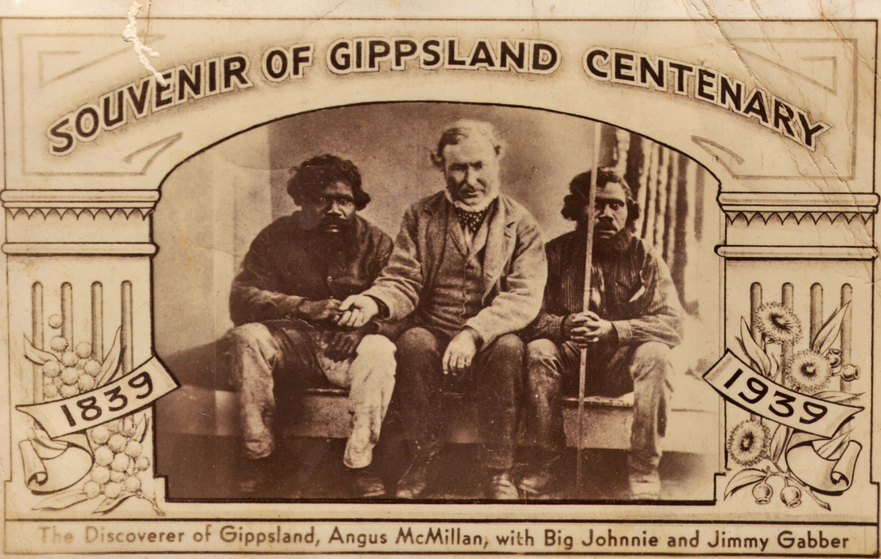
Perhaps the most apt way to name these outrageous and brutal occurrences is that they be called after the man who organised and perpetrated them: Angus McMillan. —Peter Gardner[1]
Much has been written about the massacre of Aboriginal people that is believed to have occurred at Warrigal Creek in Gippsland in 1843. Many people accept the massacre as a matter of fact, as a truism. A documentary was made in 2018 and a federal electorate was renamed that year to remove the legacy of Angus McMillan, the alleged instigator, who is otherwise remembered as an explorer, squatter, MP and Protector of Aborigines.
The current awareness of the Warrigal Creek massacre stems largely from the writing of the self-published historian Peter Gardner, who contends that his work represents “currently accepted history”.[2] His work has indeed permeated academic and public discourse, but it contains many unproven assertions that undermine his main premise, that McMillan was responsible for the massacre. McMillan is not implicated in any of the material cited as evidence against him.
This essay appears in December’s Quadrant.
Click here to subscribe
The aim of this article is to examine Gardner’s interpretation of the Warrigal Creek massacre story and his accusations against McMillan. First though, it is necessary to establish the circumstances that led to the European settlement of Gippsland and the resulting conflict with the indigenous Kurnai people, which is the root of the massacre story. This provides a contrast to Gardner’s analysis, which is based largely on a story from a schoolchildren’s magazine from 1925. To implicate McMillan, Gardner imputed words and meaning into this story that are simply not there, rendering his narrative both perplexing and questionable. This raises the inevitable question of whether the massacre story, based on Gardner’s interpretation, should be seen as historical fact or an apocryphal tale.
Part I: The Settlement of Gippsland
The Kurnai
The Kurnai people were the indigenous inhabitants of Gippsland when the first Europeans arrived. Their territory extended along the coast from Cape Liptrap in the west to Point Hicks in the east, and inland to the Great Dividing Range in the north.[3] Their customs and society were studied in detail by Alfred W. Howitt, but due to violence and the effects of disease, alcohol and the mission system, much traditional knowledge had already been lost by the time he began recording information in the mid-1860s.[4] Howitt’s pioneering anthropological work is compelling reading and provides a suitable counter to many modern narratives. One thing is clear from his work: the Kurnai men were warriors. They were feared by their tribal enemies for their ability to attack at night—a skill the Europeans were to encounter.[5]
In an essay on Gippsland from April 1843, Henry Bebb Morris described a mock fight between six Kurnai men using spears, boomerangs and waddies:
they are small men, and when in repose would not be remarked for beauty or figure, but under the excitement of the fight they put every muscle into motion, and threw themselves into attitudes which would have graced a Grecian warrior.[6]
In contrast, there is an implicit assumption in Gardner’s work that the Kurnai were passive victims of European violence, but this does not do them justice. Howitt noted that the Kurnai killed by the Europeans “were mostly, though not all, fighting men of the tribe”.[7]
The Squatters
Many histories of Gippsland have quaint notions of founding fathers, churches and shires, but the reality is that squatters occupied the region in order to capture a share of the “filthy lucre” of the Van Diemen’s Land convict economy. There were simple economic facts that led to this. Convicts were entitled to a daily ration of fresh meat, as were the military and the civilian authorities. From 1840, increased numbers of convicts were sent to Van Diemen’s Land after the cessation of transportation to New South Wales. The Commissariat let annual tenders for the supply of fresh meat and other staples. The mainland squatters wanted a share of this market and the Van Diemen’s Land butchers with Commissariat contracts needed to obtain livestock at the lowest price possible.[8]
Michael Connor: The Massacre Maps’ shoddy research
In order to export livestock, the squatters needed a port and grazing land in Gippsland, as it was the closest part of the mainland to Van Diemen’s Land. However, the region was isolated from the rest of New South Wales by mountains, rivers, forests, swamps and the fierce reputation of the Kurnai. From 1839, Angus McMillan tried on numerous occasions to reach Corner Inlet from the Monaro District and finally succeeded in February 1841 when he reached the tidal bank of the Albert River. An independent expedition from Melbourne to Corner Inlet in the barque Singapore in the same year led to the discovery of the mouths of the Albert and Tarra rivers.[9]
With an overland route opened by McMillan and a rudimentary settlement and port established on the Albert River at Port Albert, squatters began occupying the plains; by the end of 1844, the entire Gippsland squatting district had been occupied. McMillan made the first export of livestock to Van Diemen’s Land in 1842 and the trade continued until 1868 when it was halted by a tariff war between Victoria and Tasmania.[10]
Conflict with the Kurnai
When the squatters began occupying Kurnai territory with their herds of sheep and cattle, conflict soon followed. The squatters were no doubt imbued with the belief that they had the right to do so on the authority of the British Crown, which claimed sovereignty over the entire continent. McMillan’s employer, Captain Lachlan Macalister, described the squatters as “legally authorised occupiers of Crown lands”.[11] The violent response from the Kurnai was the same as that meted out to their tribal enemies when defending their territory.[12] The first reported attack on the squatters came in 1841 when, it was said, 600 Kurnai attacked Macalister’s run.[13]
The squatting runs were large tracts of unfenced land—Macalister had 100 square miles—where livestock was left in charge of shepherds and hut keepers whose job it was to tend the livestock and prevent it from straying. Many of the stock keepers were ticket-of-leave holders or assigned convict 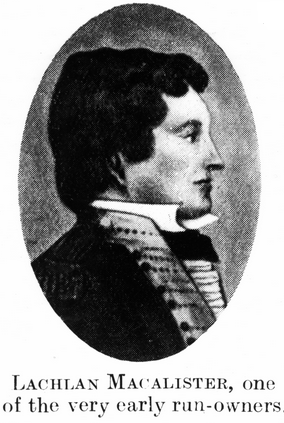 servants. The men were easy prey for the Kurnai and by mid-1843, four had been murdered. One man was killed with thirteen spears, his body was mutilated, and his arms and legs were removed—the Kurnai were cannibals.[14]
servants. The men were easy prey for the Kurnai and by mid-1843, four had been murdered. One man was killed with thirteen spears, his body was mutilated, and his arms and legs were removed—the Kurnai were cannibals.[14]
Conflict with the Kurnai was not restricted to the Europeans. Intertribal warfare was endemic in the region with raid and counter raid where men, women and children were slaughtered as they slept, and then eaten. In March 1840, twenty Bunurong men from Westernport escaped the supervision of Assistant Protector William Thomas to undertake a raid into Gippsland. They returned in triumph with flesh from the Kurnai they had killed. In October that year, ninety-seven Kurnai warriors made a revenge raid into Bunurong territory. They did not find any Bunurong so they ransacked a squatter’s station instead. Just before European settlement, the Kurnai raided as far as Brighton and Arthur’s Seat on Port Phillip Bay—a distance of at least 120 kilometres as the crow flies—and they are believed to have wiped out about half of the Bunurong. This was the cause of great enmity among the surviving Bunurong. [15]
The arrival of the Europeans changed the dynamics of this conflict with the introduction of firearms and the formation of the Native Police. Many Bunurong joined the police and used the guise of their role to extract vengeance on the Kurnai.[16] The Port Phillip Gazette reported in April 1845:
A report has been current that a whole tribe of blacks has been extirpated in the Gipps Land country, by the Western Port or Port Phillip blacks, led on by several of the Mounted Black Police; we understand that an investigation is now going on, and we may add it is one of the most extraordinary affairs we have yet heard about.[17]
This story was repeated in several of the colonial newspapers but there does not seem to have been any follow-up reports. Gardner regards tribal warfare as a myth.[18]
The Murder of Ranald Macalister
Ranald Macalister was the nephew of Lachlan Macalister and the fifth European to be murdered by the Kurnai. According to Gardner, the Warrigal Creek massacre was revenge for his murder. While the murder was well documented in contemporary newspaper accounts, the reports also indicate that by mid-1843, Gippsland was in a state of disarray. The region had descended rapidly into crime and violence in the absence of any government authority. The Australian reported in August:
The Prince George touched at Port Albert on the 25th ultimo, and reports that the Agenoria is taking in cattle there, the captain of which reported the blacks to be in a very riotous state. On the 13th ultimo, Mr. Ronald McAlister was removing his sheep station about two miles from the settlement, when he was attacked by the blacks and murdered; his body was found the following day by a native in his employ. A Mr. Nelson’s house was also attacked a few days before, and the blacks, after wounding a man in his employ, decamped with several articles of his property.[19]
The Geelong Advertiser reported the murder:
It is reported that Mr. McAllister was decoyed from his station by a party of blacks on pretext of having found a flock of sheep that had been missing, and that having got him to a spot favourable for their murderous purpose, they set upon him with their waddies, and despatched him under circumstances of the utmost barbarity.[20]
Following the murder, Lachlan Macalister wrote a letter to Governor Sir George Gipps via the Sydney Morning Herald in which he implicated the governor for the state of anarchy in Gippsland due to the lack of official protection. He stated:
Mr. Ranold McAlister, nephew of the allegorical author, was dragged off his horse, and cruelly murdered, on the township of Alberton, his head being so totally disfigured that his countenance could not be recognised among even his most intimate friends, by these harmless, innocent denizens of the wild of Gipps Land …
Macalister stated that escaped convicts were committing “the most revolting crimes the calendar can name—such as murder, rape, robbery, forgeries, cattle-stealing, and last, though not least, sly grog-selling, the root of all crime”. He also stated:
There are many persons congregated in Alberton, without any visible means of earning a livelihood, a parcel of the most lawless rogues. Runaways from the settlers, and others have located themselves in some vacated huts on the Tara River, rendering it dangerous for passengers to approach this neighbourhood … Your Excellency cannot for the sake of humanity, good government, well-being, and the safety of this district, much longer withhold from us the protection of those laws which we have a right to demand at your Excellency’s hands …[21]
The newspapers indicate that the murder was not an isolated event and occurred within a wider context of anarchy and violence involving the Kurnai and the convicts. No reason was given for the murder. Lachlan Macalister’s demand of Gipps to provide protection for the settlers gives the impression that the settlers were on the defensive against both the Kurnai and the convicts.
There were further reports of violence involving the Kurnai in April 1844 when the Sydney Morning Herald printed a letter from a Gippsland squatter:
The blacks are still continuing their outrages—burning huts, robbing people’s gardens, and slaughtering cattle by wholesale. Messrs. Pearson and Cunninghame have been the latest sufferers by those cannibals; it is not only the stock they kill we feel the loss of, but running the remainder off their runs, and the expense the proprietors are put to in collecting their cattle, and procuring guns and ammunition for everyone engaged in their employment.[22]
This letter indicates that the Kurnai were still harrying the squatters the year after the massacre is believed to have occurred—there was conflict with the Kurnai before and after the murder of Macalister. It also suggests that the squatters were unprepared for the resistance they faced.
Charles Tyers
Captain Charles Tyers RN arrived in Gippsland in January 1844 as the Commissioner for Crown Lands. He was joined by detachments of the Border and Native Police. He wrote a number of reports on the state of Gippsland to his superior, Charles La Trobe, the Superintendent of the Port Phillip District.
In July 1844 he wrote, “I regret however to observe that the depredations of the Aborigines continue and that the small police force at my disposal is inadequate to put a stop to them.” He went on to describe how “the natives have been very troublesome, killing 90 head of cattle belonging to Mr Sparks, at various times, and many belonging to Mr Jones”.[23] To put this in context, crimes against livestock carried a heavy penalty. A European convicted of cattle stealing in the Port Phillip District faced the penalty of transportation for fifteen years; in Van Diemen’s Land, it was for life.[24]
In 1845, Tyers reported on the Aborigines, stating:
In the early part of 1843—as I have been informed, some of the Corner Inlet tribe were occasionally employed by the few Settlers at Port Albert in carrying fire wood and in other light work for which they generally received payment in flour & c—but since the unprovoked murder of Mr Ronald Macalister by them at Port Albert, about that time, they have not been seen in the neighbourhood.
In other parts of the District, prior to my arrival, they had occasionally come into collision with the Settlers—the consequence of which was the murder of four shepherds—and as far as I can learn without any provocation—they have also committed, and are still committing, many depredations on the stock of the Settlers—which from the nature of the country, and the known fact of their carrying on their depredations at night, it is difficult to prevent.[25]
Tyers noted that the Kurnai were geographically isolated from all of the neighbouring Aboriginal tribes, none of whom could understand their language, and “From this circumstance, the Chief Protector [Robinson] on his visit to Gipps’ Land last year, was unsuccessful in his attempts to communicate with them.” The isolation from the other tribes meant that “their fierce and predatory habits have received no check”.[26]
At the end of 1845, Tyers wrote a follow-up report stating:
since the return of the Native Police to Head Quarters … the depredations of the Aborigines of the District on the property of the Settlers, including horses as well as horned stock, have increased to an alarming extent—and that I cannot at present suggest any other means of prevention, than the continuing service of the Native Police.[27]
The official reports from Tyers to La Trobe from 1844 to 1845 thus describe the situation in Gippsland where the settlers were being attacked by the Kurnai and their stock was being killed. His reports correlate with the newspaper accounts in describing the violent state of Gippsland.
The Convicts
Convicts were present in the early years of settlement in Gippsland in two very different ways: first, as the slave labour of the squatters, and second, as escapees congregated around Alberton.
Tyers’s Convict Return for 1844 shows that convict labour was an integral part of the squatter economy. He recorded that there were fifty-five Prisoners of the Crown in Gippsland, nine of whom were in government service. This included five in the Border Police, one of whom held a ticket-of-leave. This implied that the other four police were assigned servants, or “white slaves”, as John Pascoe Fawkner, the editor of the Port Phillip Patriot and a fierce critic of the convict system, called them. The other forty-six convicts were employed on the squatting runs. The return did not include ex-convicts.[28]
Within a period of two years, it appears that Gippsland became a haven for escapees. This changed 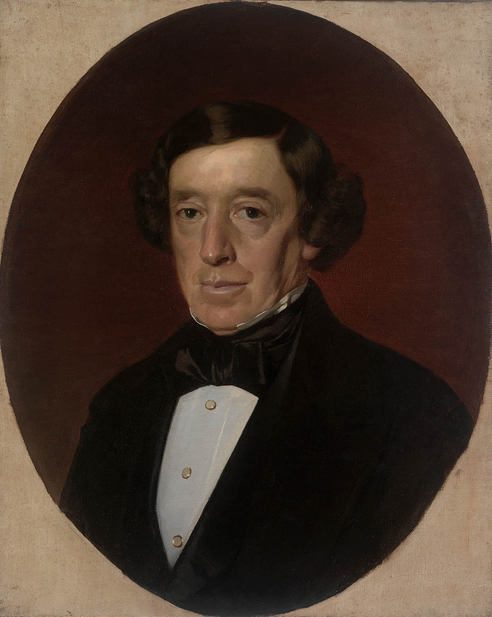 with the arrival of Tyers, who told La Trobe:
with the arrival of Tyers, who told La Trobe:
The run-away Convicts, and other bad characters with which the District was infested a few months ago have, I believe been nearly all driven out by the system of surveillance pursued by the Border Police, acting under my instructions.[29]
The Chief Protector of Aborigines, George Augustus Robinson (right), noted that the settlers were not the only ones to suffer from the convicts:
There is however reason to fear that before the arrival of the Commissioner a large amount of mischief had been inflicted upon the original Inhabitants by the lawless and depraved who had infested the port from Van Diemens Land and the Middle Districts [present-day New South Wales] and that the instance recorded (if reports be true) is not the only one in which the Blacks have suffered.
Robinson’s comments are significant in that he was revealing that escaped convicts were responsible for mistreating the Kurnai. Convicts under the control of the penal system in the Port Phillip District and elsewhere were notorious for their crimes against the Aborigines. Fawkner blamed them for most of the conflict between the Europeans and the Aborigines.[30] Escapees living outside the law would therefore have posed a dire threat to the Kurnai.
The quote from Robinson is from Gardner’s book, Through Foreign Eyes; he says Robinson was “incorrect” to blame the convicts, because “The hostile collisions that occurred following the murder of Macalister and others in Gippsland were carried out by the squatters and their employees.”[31] This “correction” suggests that Gardner entirely overlooked the substance and significance of Robinson’s observations.
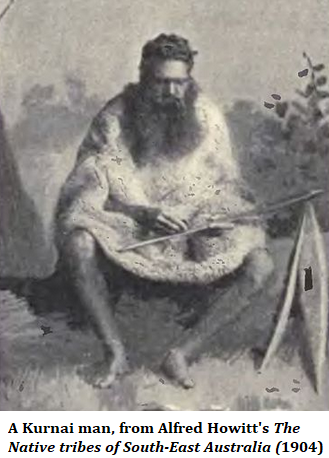
Part II: Peter Gardner’s Narrative
Peter Gardner has written three books in which he asserts that Angus McMillan, “The Butcher of Gippsland”, was responsible for several massacres of Kurnai people. He calls them “The McMillan Massacres”.[32] Gardner’s work has been influential and generally unquestioned. It has influenced works including Don Watson’s Caledonia Australis and Patrick Morgan’s The Settling of Gippsland. It is cited in the Australian Dictionary of Biography entry for McMillan, which is in turn cited on the Victorian Parliament website. Emotional articles in the Guardian in 2019 parroted the denunciation of McMillan, as did the Gippsland Times in June 2020.[33] His work was cited widely in a motion to remove monuments to McMillan put before the Wellington Shire Council in June 2020. Perhaps the most revealing example of Gardner’s influence is Cal Flynn’s Thicker Than Water, in which McMillan is denounced by his own descendant.
Gardner claims his work is “partly political and partly moralistic”; he disdains objectivity and describes his politics as “left”.[34] How “left” is open to interpretation given that his third book, Our Murdering Founding Father (a diatribe against McMillan), begins with the “property is theft” quote from the nineteenth-century anarchist Pierre-Joseph Proudhon. Gardner’s work has hints of Marxist reductionism, where the Kurnai are portrayed as living in an Arcadian “economy” that was destroyed by the expansionary capitalism of the land-hungry squatters.[35] This simplistic reductionism obscures the complexity of Gippsland’s early history, evident in his rejection of Robinson’s observations on the escaped convicts.
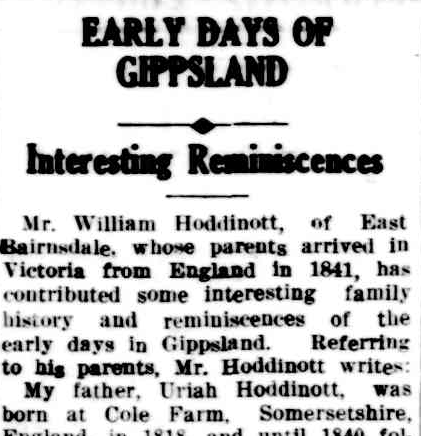
The Evidence: Gippslander
Gardner’s evidence for Angus McMillan’s involvement in the Warrigal Creek massacre consists of a story written for The Gap school magazine in 1925 by William Hoddinott under the pseudonym of Gippslander. Gardner’s method in telling the story is to first present the massacre and McMillan’s involvement as matters of fact. In Chapter 1 of Gippsland Massacres, he states:
There was a brigade formed by McMillan, which according to “Gippslander”, was called the Highland Brigade, and mainly consisted of Scotsmen who swore before God and their Queen not to inform on their fellow desperados, and to maintain complete secrecy of the affair in which they were about to participate. They murdered, according to “Gippslander”, 150 at Warrigal Creek, which would make it one of the largest known massacres of Aborigines in Australian history.[36]
The Gippslander account mentions the Highland Brigade and a death toll of 100 to 150, but McMillan’s involvement, Scotsmen, the swearing to God and the Queen, and secrecy, are entirely Gardner’s creation. He has attached his own assertions to his source material without distinguishing between them, and these assertions are made without proof or explanation. In Chapter 4, he gives another rendition of the Gippslander story, stating the massacre “was lead [sic] by McMillan”.[37] Again, no proof is offered.
Chapters 6 and 7 of Gippsland Massacres retell the story. Gardner prefaced the following quote from Gippslander stating that after the murder of Macalister, “An avenging party set out under the leadership of Angus McMillan …”
The brigade coming up to the blacks camped around the waterhole at Warrigal Creek surrounded them and fired into them, killing a great number, some escaped into the scrub, others jumped into the waterhole, and, as fast as they put their heads up for a breath, they were shot until the water was red with blood.[38]
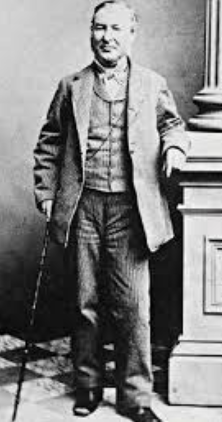 The quote continues in Chapter 7:
The quote continues in Chapter 7:
I knew two blacks who, though wounded, came out of that hole alive. One was a boy at the time about 12 or 14 years old. He was hit in the eye by a slug, captured by the whites, and made to lead the Brigade from one camp to another. He was afterwards adopted by one of the party and called “Bing Eye”. The other was a little older; he made his escape up the creek by swimming and diving. He was shot through the foot and was so injured that he was called “Club Foot”.[39]
These passages represent the sum total of Gardner’s evidence against McMillan (left), but he does not explain how the story implicates McMillan. Rather, his involvement is presented as a fait accompli. McMillan is mentioned once by Gippslander, where he is supposed to have caught Macalister’s horse on the road to Sale (which did not exist then).[40] Otherwise, he has no involvement in the story.
Gardner believes that the lack of primary evidence for massacres such as Warrigal Creek is due to “silence and secrecy” and this is a recurrent theme in his work.[41] The conspiracy of secrecy is used to explain why Hoddinott “probably with good reason, chose to remain anonymous, as the account implicated Angus McMillan … as the leader of this murderous retaliation”.[42] Elsewhere he states that Hoddinott’s “desire to remain anonymous would seem to indicate that the telling of the story may have had undesirable repercussions”.[43] The fallacy of this secrecy argument is that it is contradicted by Gardner’s own evidence from William Thomas from 1845 and other versions of the massacre story that pre-date Gippslander by more than fifty years (see below).
Gardner accepted Hoddinott’s Gippslander story literally and uncritically, stating that it is “completely reliable” due to its “vividness and detail”.[44] The word colourful may have been more appropriate. The story was written anonymously for a magazine for primary school children eighty-two years after the incident described, without attribution, and by someone who was not there. Gardner claims it is a secondary source but it is, at best, folk history that he has embroidered with his own fiction about McMillan.
Coincidentally or not, the Australasian newspaper published stories between 1923 and 1925 with a one-eyed Aboriginal character named Bing-eye; the term “club foot” was ubiquitous. Some of the tale also bears a resemblance to accounts of the Hospital Creek massacre in New South Wales that emerged between 1911 and 1919, in which the survivor was a one-eyed Aborigine.[45] Hoddinott’s tale thus appears to contain generic elements from the period. Before declaring Hoddinott’s tale to be “completely reliable”, it would have been prudent to analyse its contents.
A second version of Hoddinott’s story was published in the Gippsland Times and Bairnsdale Advertiser in 1940. Gardner cites this version to confirm that Gippslander was in fact Hoddinott but he does not mention that the two versions contain a number of significant differences. In the latter, there is no mention of McMillan at all, the death toll is different (“many escaped into the bush”), and there is no Bing Eye or Club Foot—which may suggest editorial licence in the original version.[46] Gardner admonished Hoddinott, stating, “in this account he failed to implicate McMillan as he had done 15 years earlier”—but neither version implicated McMillan.[47]
William Thomas
In Through Foreign Eyes, Gardner quoted the journal of William Thomas, the Assistant Protector of 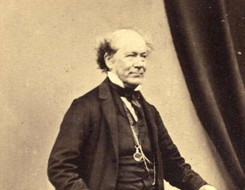 Aborigines. Gardner claims—incorrectly—that Thomas “was aware of the circumstances of the Warrigal Creek massacre, as he had recorded the details of it on two separate occasions”.[48] Thomas (right) recorded a conversation with a man named Hatcher who Gardner believes was the brother-in-law of a Gippsland squatter named Buntine. Thomas wrote in April 1845:
Aborigines. Gardner claims—incorrectly—that Thomas “was aware of the circumstances of the Warrigal Creek massacre, as he had recorded the details of it on two separate occasions”.[48] Thomas (right) recorded a conversation with a man named Hatcher who Gardner believes was the brother-in-law of a Gippsland squatter named Buntine. Thomas wrote in April 1845:
He said he and another man had come unarmed from Gippsland. I asked him if he was not afraid of meeting the Blacks, his reply was, Blks Sir no fear of them now they would run away as soon as they see a white man but there are not many left, he said he had a Brother who had been in Gippsland from the first his name was Bunton & kept a Public house in Gippsland by the Dirty Water Holes & a cattle station joining to Mr. McAllister who was killed, that after Mr. McAllisters murder great slaughter of the blacks took place and that on his brothers station a cart load of Blks bones might be gath.rd up …[49]
This was written two years after the murder of Macalister; stating that the slaughter took place after the murder does not necessarily mean that it took place because of the murder. Most importantly, it does not say where—if Hatcher’s account is reliable, he was clearly not speaking about Warrigal Creek. Buntine’s Bruthen Creek run was several miles and several squatting runs to the west of Warrigal Creek.
In the revised edition of Gippsland Massacres, Gardner reinvented the account, claiming “the bones were carried away from the [Warrigal] Creek by the cartload”. He also claimed this appeared to be part of a cover-up due to the arrival of Tyers or Robinson.[50] This raises two issues: first, this is a fallacious misuse of the material; Hatcher said the bones might be gathered up—his might be has transmogrified into Gardner’s were. Second, Hatcher arrived in Gippsland several months after Tyers, so it was just a tad late to be a cover-up.
Some basic research puts Hatcher’s account into context. Gardner omitted a part of the quote that indicates Hatcher travelled to Gippsland with a man named Bennett.[51] The latter’s wife, Lavinia, published a well-known account of their journey. They travelled with Edward Hobson, who was attempting to find an overland route to Gippsland. Robinson was also attempting to do the same, although by a different route. He was accompanied by George Henry Haydon, who published an account of their journey, which is also well known. Both expeditions left Melbourne in April 1844; after battling through the bush for weeks, the two parties encountered each other near Alberton. In other words, by coincidence, Robinson and Hatcher arrived in Gippsland at exactly the same time.[52] There could not have been a cover-up if human remains were still visible after their arrivals. Gardner’s cover-up conspiracy theory thus rests on an obvious misrepresentation of Hatcher’s account. Hatcher appears to suggest that there was a massacre at Bruthen Creek; Gardner has either ignored or failed to grasp this to make the account fit his Warrigal Creek narrative.
The second piece of evidence from Thomas is the record of his conversation with the Gippsland squatter Henry Meyrick in January 1847. Thomas wrote that Meyrick
… gave me a most awful statement of doings in Gippsland & tho’ he stated the utter impossibility of bringing forward valid evidence to convict in a court of law, yet the awful spectacle of human skeletons & pack[s] of bones & report[s] of doings within the last 3 yrs, shows that the Aborigines have been cut off in awful numbers, & the residue left almost totally destitute, in fact he said how they lived God only knew as they were driven … to the Lakes & Lagoons where Europeans would not follow them, that the Maneiro Blks (encouraged he believed by the early Settlers) [had] been very instrumental with the Black Police of awfully thinning their numbers … that the Awful Sacrifice of life after the Murder of Mr McAlister was awfully reckless & merciless ...[53]
The timing of this record is important because it was made after two of the three searches for a white woman allegedly held captive by the Kurnai. According to Tyers, at least fifty Kurnai were killed by the Native Police and other Aborigines attached to the search parties.[54] Meyrick arrived in Gippsland in 1845 so he was not a witness to anything before that date.[55] The murder of Macalister may have marked a turning point in which the Europeans went on the offensive. However, Thomas, Hatcher and Meyrick did not mention Warrigal Creek as Gardner claims—and they certainly did not mention McMillan. Gardner claimed in June 2020 that Meyrick gave a death toll of about 150 for Warrigal Creek, which he did not.[56] These accounts nonetheless provide evidence of the otherwise unrecorded conflict between the Europeans and the Kurnai at places such as Bruthen Creek.
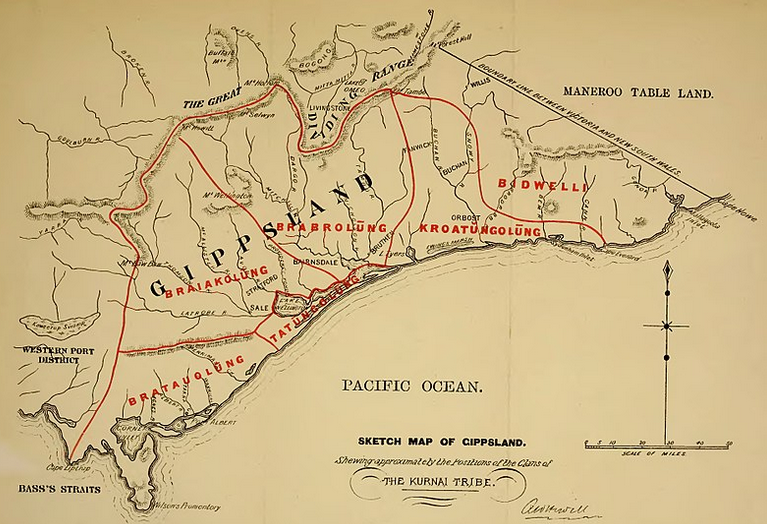
Part III: Other Versions of the Massacre Story
George Dunderdale
George Dunderdale was the Clerk of Courts at Alberton and lived at Tarraville from 1869 to 1889. During this time he collected information for stories that were published in the magazine Austral Light. The stories were republished as The Book of the Bush in 1898. These stories contain the earliest known account of a massacre as revenge for the death of Macalister. According to Dunderdale, Donald Macalister fired at some Kurnai without any provocation. The next day, while on horseback, he was speared through the neck from behind. His body was mutilated and stripped, and it was found the next day by an Aboriginal boy in his employment. Word of the murder was sent to Lachlan Macalister. Dunderdale states:
Lachlan Macalister had a long experience in dealing with blackfellows and bushrangers; he had been a captain in the army and an officer of the border police. The murder of his nephew gave him both a professional and a family interest in chastising the criminals, and he soon organised a party to look for them. It was, of course, impossible to identify any blackfellow concerned in the outrage, and therefore atonement must be made by the tribe. The blacks were found encamped near a waterhole at Gammon Creek, and those who were shot were thrown into it, to the number, it was said, of about sixty, men, women, and children; but this was probably an exaggeration.[57]
There are two significant aspects to this story: Dunderdale specifically named Lachlan Macalister as the perpetrator and he added the caveat on the death toll. Presumably he had reasons for both, but he did not say why and he did not reveal the source of his information. He added that one of the Kurnai involved in the murder survived and often re-enacted his part in the ambush.
Gardner is dismissive, claiming that “Some parts of this account are definitely wrong” on the basis that Dunderdale referred to “Macalister of Nuntin”. Gardner says “this was almost certainly McMillan of Nuntin” and that Dunderdale was “mistaken” as “the person he was most likely referring to was McMillan of Bushy Park”.[58] Apart from the perverse logic of this claim, it is factually incorrect. Gardner himself refers to Nuntin as the station established by McMillan for Macalister on western side of the Avon River in October 1840.[59] McMillan’s Bushy Park run was on the eastern side of the Avon. The area of Nuntin is on the western side of the Avon and was shown in a survey map of 1857.[60] Dunderdale’s geography was correct and it is just possible he knew who he was referring to, given that he arrived in the district just twenty-six years after the event he described—well within living memory. Once again, Gardner “corrected” historical material when it did not agree with his Warrigal Creek narrative.
To discount Macalister’s involvement, Gardner states there is no proof he was in Gippsland before 1848. Macalister’s letter to the Sydney Morning Herald in 1843 and a search of Trove and the PROV websites reveal that this statement is incorrect.
R.L. Bell
Gardner cites other versions of the death of Macalister and the massacre to build his narrative, all based on Gippslander or otherwise post-Dunderdale. However, he has not included a much earlier reference to the massacre. In a letter to the Age in August 1874, R.L. Bell stated:
The historic pen of Victorian settlement would paint with truth the horrors of many a scene of Gipps Land life; it was in 1843 … that the aggressions of the blacks were so frequent. Shepherds worked in pairs, armed, as if in an enemy’s country, to resist them; and it was 1843 that ended by wholesale destruction, the massacres at Warrigal Creek and Bundalaguah Swamp, where only one aboriginal was left to tell the story of how they died and the history of his race.[61]
This account is much closer in time to what may have happened at Warrigal Creek but Bell did not reveal how he knew of the massacres. The reference to Bundalaguah Swamp has previously escaped notice. Bell’s account is matter-of-fact and he did not name McMillan or any other person. Like Dunderdale and Thomas, he did not mention a mythical Highland Brigade and he was clearly not constrained by Gardner’s imaginary secrecy.
Bell’s account and the report of the massacre involving the Native Police in April 1845 can be found by simple searches on Trove. Their prior absence from the discourse may indicate the level of research in this area.
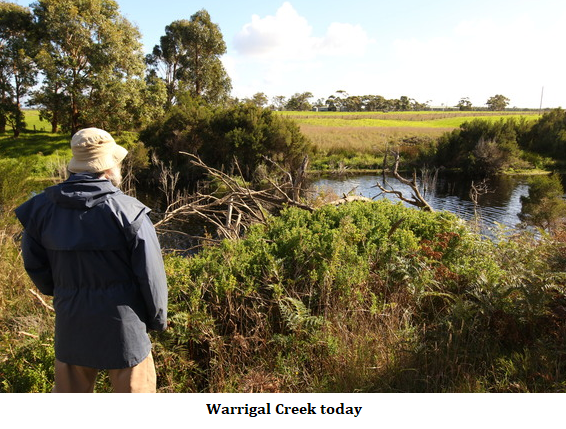
Conclusion
The Van Diemen’s Land convict economy provided the economic motives for the European settlement of Gippsland, which in turn led to conflict with the Kurnai. The historical record of this conflict up to 1843 is sparse and consists of just a few newspaper reports. Nonetheless, it demonstrates that the early settlement of Gippsland was marked by violence involving the Kurnai, the settlers and convicts. The newspapers and Charles Tyers’s reports indicate that attacks by the Kurnai continued in 1844 and 1845; they did not end at Warrigal Creek in 1843. The murder of Ranald Macalister may have been the pretext for an attack on the Kurnai at Warrigal Creek or Gammon Creek but this is not borne out by the contemporary historical record.
The question posed at the start of this article was whether Gardner’s Warrigal Creek massacre story should be seen as historical fact or an apocryphal tale. The answer is in three parts.
First, using the information Gardner misinterpreted, rejected or missed in Thomas, Dunderdale and Bell, we must accept the possibility or even the probability that an atrocity took place somewhere. Establishing the factual basis of this will require in-depth research to uncover any written evidence before Bell’s account from 1874, as well as archaeological evidence at locations such as Bruthen Creek and Bundalaguah Swamp.
Second, Gardner’s narrative is based on the assertion that the massacre and Angus McMillan are synonymous, but he has produced no evidence whatsoever to implicate McMillan. His alleged role in the massacre is a construct entirely of Gardner’s own making, where he attached McMillan’s name to the Gippslander story without revealing this to his readers.
Third, Gardner’s narrative is constructed around a story written for schoolchildren in 1925, a story that could at best be considered as folk history. It beggars belief that it was accepted as a “completely reliable” historical source. Gardner’s fiction about McMillan, his misquoting of source material, and his reliance on an unattributed, anonymous and generic story truly relegates his Warrigal Creek narrative to the realms of the apocryphal.
Despite these obvious failings, a legion of dittographers in academia and the media have slavishly repeated and amplified this apocrypha without exposing its errors and falsehoods, or questioning its underlying assertions and lack of evidence.
We are yet to have a complete understanding of Gippsland in the 1840s. Establishing this will entail the evaluation of all historical themes and not rejecting or ignoring evidence because it does not fit a preconceived narrative. Some themes may be unpalatable, including tribal warfare, the murderous role of the Native Police, and the role of convicts as both slave labour and perpetrators—they are part of the historical record but not always part of the written history. The history of early Gippsland will invariably include many intersecting and conflicting narratives. To date, there is nothing to suggest that it will include Angus McMillan leading the Charge of the Highland Brigade.
Peter Gardner deserves recognition for highlighting the reality of conflict in early Gippsland. Beyond this, the subject needs a complete reassessment and the instilling of some academic rigour. Considering that Gardner has political motives and a disdain for objectivity, his work should perhaps be seen as a political campaign rather than as history. Unfortunately, in Gippsland, his diatribe against McMillan has been conflated with issues such as Reconciliation and Black Lives Matter. His words continue to have influence and have provided a convenient but misplaced source of outrage—and how does the community benefit from having negative sentiments engendered on a false premise? If a historical narrative is to be used as the basis for debate or action in the public sphere, it should be grounded in non-partisan, objective research and analysis. So far, this has been lacking.
[1] Gardner, P. D. (1993) Gippsland Massacres (third edition) Ngarak Press, Ensay, Victoria, p. 66
[2] Gippsland Times 30 June 2020, p. 10
[3] Howitt, A W (1880) ‘The Kurnai: Their Customs in Peace and War’ in Fison, L. and Howitt, A W Kamilaroi and Kurnai Anthropological Publications, Oosterhout, facsimile edition, pp 227-29
[4]Op cit p.186
[5] Op cit pp.213-214
[6] Morris, H. B. ‘A trip to Gipps’ Land in April 1843’ The Courier 23 June 1843, p.4
[8] Caldow, W (2012) Gippsland and the Van Diemen’s Land Livestock Trade: The Log of the Dew Drop 1847-49, The Great Circle, Vol 34, No. 2, pp.20-21
[9] Cox, Kenneth (1973) Angus McMillan: Pathfinder, Published by the author
[10] Caldow (2012) p.25; Caldow W (2010) The early livestock trade between Gippsland and Van Diemen’s Land: insights from Patrick Coady Buckley’s journal of 1844. The La Trobe Journal, 86, 23-36.
[11] Sydney Morning Herald 6 September 1843, p.2
[12] Howitt p.214
[13] Port Phillip Patriot 23 December 1841, p. 3
[14]Cornwall Chronicle 17 June 1843, p.4
[15] Fels, Marie Hansen (2010) I Succeeded Once: The Aboriginal Protectorate on the Mornington Peninsula 1839-1840 , ANU E-Press, pp 249-271
[16] See also: George Henry Haydon (1846) Five Years Experience in Australia Felix pp151-152 (on-line edition)
[17] Port Phillip Gazette 30 April 1845 p.2
[18] Gardner, P D (2005) The Myth of Tribal Warfare On-line essay
[19] Australian 2 August 1843, p.3
[20] Geelong Advertiser 5 August 1843, p.2
[21] Sydney Morning Herald 6 September 1843, p.2
[22] Sydney Morning Herald 15 April 1844, p. 4; the article appears to have Lachlan Macalister’s turn of phrase.
[23] Inwards correspondence Tyers to La Trobe 44/1367 p.5 PROV
[24] Port Phillip Gazette 21 May 1842, p.3
[25] Tyers to La Trobe Inwards Correspondence 45/324 PROV
[26] Op cit
[27] Tyers to La Trobe Inwards Correspondence 46/219 PROV
[28] Tyers to La Trobe Inwards Correspondence 44/2112, PROV; Port Phillip Patriot 12 August 1839, p.4
[29] Tyers to La Trobe Inwards Correspondence 44/1367, p.4, PROV
[30] Port Phillip Patriot 12 August 1839, p.4
[31] Gardner, P. D. (1994) Through Foreign Eyes, Ngarak Press, Ensay, p.45
[32]Gardner (1993) p.58; (1990) Our Murdering Founding Father, 2nd Edition, Ngarak Press, p.28
[33] The Guardian 6 March 2019; 8 March 2019; Gippsland Times 16 June 2020
[34] Gardner (1993) pp 6-7; (2015) Some Random Notes on Massacres 2000-2015 (on-line essay)
[35]Gardner (1993) pp 43-44
[37] Op cit p.36
[38] Op cit p.53
[39] Op cit p.64
[40] Gippslander (1925) ‘Experiences with Gippsland blacks’, The Gap, Education Department, Bairnsdale Inspectorate, Omeo, pp 5-6. The Gippslander story consists of just over a page; within it there is a myriad of minor details that are contradicted by the contemporary newspaper reports.
[41] Gardner (1993) p.101
[42] Op cit pp 97-98
[43] Op cit p. 64
[44] Op cit p. 53
[45] Australasian 15 September 1923 p. 55; 31 January 1925; Glen Innes Examiner 31 August 1911 p. 6; Smith’s Weekly 12 April 1919, p. 15
[46] Gippsland Times 23 May 1940, p.5
[47] Gardner (1990) Our Murdering Founding Father, Ngarak Press, Ensay, p. 40
[48] Gardner (1994) p.51
[49] Op cit p.51
[50]Gardner (1993) p.16
[51] Stephens, Margeurita, transcribed from the journal of William Thomas; cited on Peter Crowley’s website Snow on the Jeeralangs
[52]Adams, John (1990) From These Beginnings, Alberton Shire Council, Yarram, p. 21
[53] Gardner (1993) p.51-52
[54] Tyers, Charles 1859 Submission to the Select Committee on Aborigines, Government Printer, Melbourne, p.77
[55] Gardner (1994) p.23
[56] Gippsland Times 24 June 2020 (on-line edition)
[57] Dunderdale, George (1898) The Book of the Bush, Ward Locke, London, pp.214- 215
[58] Gardner (1993) p.54; p.63
[59] Gardner (1990) p.18
[60] ‘County Lands in the Parishes of Bundalaguah and Nuntin,’ 1857, W T Dawson, District Surveyor, on-line copy, NLA
[61] The Age 8 August 1874: 7
 Sign In
Sign In 0 Items (
0 Items ( Search
Search









Wayne, a very valuable and comprehensive article. In my research for Bitter Harvest, I could find no reference, in original sources, to ‘The Highland Brigade’, established, according to the Gardner version of history, to seek out and exterminate blacks. That’s not to say they don’t exist, but if you have knowledge of such I would be grateful to know it.
Gardner’s reliability can best be judged by his rewriting of an inter-tribal massacre at Tambo Crossing. Originally reported by Robinson as such, Gardner has interpreted an obscure comment by Robinson to argue that it was actually a massacre by settlers that Robinson was covering up.
Is there any aspect of our history that has now not been corrupted by the SJWs?
Might be very hard to find one March.
Personally, it,s hard to know who to believe, such is my lack of confidence. Oh how I wished I had written down the stories my grandmother used to regale us with.
I ill not believe anything about aboriginal history that does not have the Indigenous Seal of Approval by the Bruce Pascoe Ministry of Truth.
An excellent and detailed correction of Gardner. But I wish to look forward, unimpeded by SJW’s.
Happy New Year to all. Please note and use or adapt the following words. And forward if you like.
“I welcome you all to (insert place name). Our land of migrants, from the very first in their canoes or who even walked here. Those who came in chains, those who fled famine, those who fled or survived genocide and war and it’s consequences. To those who came by jet plane yesterday. We acknowledge that in our past, as in most nations, bad things have happened. But we strive to be one people, equality of opportunity for all, no privilege by birth, truly one nation. Welcome to you all.”